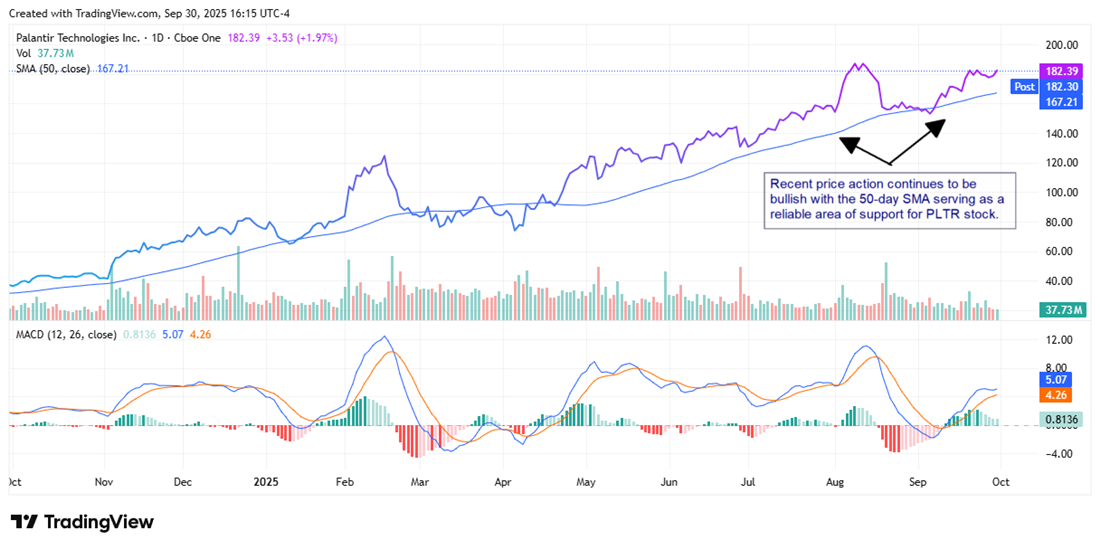Ticker Reports for October 1st
Why Amazon's Latest Upgrade Might Be Its Most Important Yet
Amazon.com Inc (NASDAQ: AMZN) has been one of the market’s hottest tech stocks in recent years, and remains one of its most closely followed. It conquered e-commerce, turned cloud computing into a household term, and built an advertising business on track to bring in more than $60 billion this year. But while its fundamentals are undoubtedly impressive, its stock has frustrated investors in recent months.
Despite the broader equity market pushing on to fresh records almost weekly since July, Amazon has yet to close above last February’s all-time high. Shares have repeatedly run into resistance around the $240 mark, failing to push through on multiple occasions over the past nine months, including twice in the past two months alone.
This pattern has formed what’s known in technical analysis as a “triple top,” a bearish setup that often warns of tiring bullish momentum. The failure to clear such a level, particularly in an environment of strong risk-on sentiment and supportive macro conditions, raises uncomfortable questions about whether Amazon’s rally is stalling.
Against that backdrop, last week’s upgrade from Wells Fargo may carry far more weight than the market initially appreciated. Let’s jump in and see why.
Technical Resistance Turns Into a Warning Sign
A triple top occurs when a stock fails to break through the same resistance level three times in succession. Each rejection signals that buyers lose conviction at that price point, and over time, the repeated failures can create a ceiling that grows harder to crack.
For Amazon, that ceiling is $240. As we’ve flagged multiple times in recent weeks, the stock has rallied hard up to that level, only to be beaten back into a retreat. The most recent attempts in July and early September came during periods of broad market strength, with indexes pushing higher on renewed optimism around cooling inflation, falling interest rates, and strengthening economic growth.
It is concerning that Amazon could not capitalize despite these tailwinds, and the bears are right to wonder if the stock’s weakness is a canary in the coal mine.
Wells Fargo Upgrade Carries Extra Weight
However, all this makes last week’s analyst update all the more significant. For months, the company has collected reiterated Buy ratings from Wall Street, a steady chorus that added little incremental conviction. Last Wednesday, however, Wells Fargo upped its rating from Equal Weight to Overweight, a material upgrade that stands out from Telsey Advisory Group’s reiterated Outperform rating on the same day.
While it can’t be said Wells Fargo was an out-and-out bear on Amazon shares, the upgrade does suggest they are throwing in the towel and committing to the bull case. The fact that this is happening in the face of the stock’s ongoing failure to break through $240 suggests the team there has a high degree of confidence in this happening soon.
Their rationale was centered on Project Rainier, Amazon Web Services’ next-generation initiative expected to accelerate cloud revenue growth. With AI workloads surging, Wells Fargo believes AWS is positioned to reaccelerate after a period of slower growth. In addition, Amazon’s expanding advertising arm and relentless retail scale give it multiple levers to pull, strengthening the long-term outlook.
Can Amazon Finally Break Through?
For investors looking for other tailwinds to get excited about, beyond AWS, Amazon continues to deliver on multiple fronts. Its advertising unit is one of the fastest-growing businesses in the digital economy, while its e-commerce Prime business remains the linchpin of its retail empire. October’s upcoming Prime Day is expected to collect billions in consumer spending.
These engines give Amazon a depth of growth drivers that most companies can only dream of. In recent weeks, the issue has been translating these solid, if not actually improving, fundamentals into price performance.
The Wells Fargo upgrade underscores that, despite the stock’s frustrating chart, now is not the time to give up on Amazon. Instead, the opposite is the case. The underlying businesses remain strong, and the stock could soon have enough momentum to break through to fresh highs.
The Tiny Stock Set to Soar with Musk's AI Ambitions
The Tiny Stock Set to Soar with Musk's AI Ambitions
Lamb Weston: Is the King of Spuds a Buy or a Dud for 2026?
Lamb Weston’s (NYSE: LW) FQ1 report and guidance update affirm that the king of spuds is no dud. This company reaffirmed its guidance, which in turn reaffirms the cash flow and capital return outlook, and the capital return is solid. This FMCG (fast-moving consumer goods) company pays a substantial dividend and buys back shares aggressively, providing leverage for long-term investors and potential for a double-digit total return over time.
Lamb Weston’s dividend is attractive enough for investment in its own right. The stock yields 2.5% in early October and is accompanied by a positive outlook for distribution increases. The payout ratio is relatively high compared to the earnings outlook, at about 60%, but not an insurmountable level, and is in alignment with its industry. The more critical ratio is the cash flow payout ratio, which was only 17% in Q1, low enough for investors to assume the double-digit distribution CAGR will be sustained.
The buybacks are substantial. The company reduced its share count by 2% in F2025 and is on track to reduce it by a comparable or larger amount in F2026. The pace topped 3.5% in FQ1, and there is sufficient capital left under the current authorization to continue at a similar pace in upcoming quarters.
There are no red flags on the balance sheet. The balance sheet highlights at the end of Q1 include reduced assets offset by a reduction in liabilities, low leverage, and improved equity. Equity increased despite the decrease in share count and additional distributed capital.
Lamb Weston Sustains Growth in Tough Environment
Lamb Weston’s FQ1 was solid, with revenue growing approximately 0.5% to outperform MarketBeat’s consensus estimate. The $1.66 billion in revenue was driven by a 6% volume increase and 1% impact from FX translation, offset by a 7% decline in price.
The price decline is significant but not unexpected. It is tied to the closing of its Washington plant and the discontinuation of products made there. The negative impact is not expected to persist and is anticipated to lead to improved margins over time. Segmentally, International markets were strongest, growing by 4% under the influence of FX translation, while the North American market contracted by 2%.
The margin news is mixed but otherwise favorable to shareholders. The company experienced margin pressure in virtually all comparisons, but the declines were less than expected, linked to one-offs and price-mix changes related to discontinued product lines. The key point is that GAAP of 74 cents exceeded MarketBeat’s reported consensus by 21 cents, or about 4000 basis points, which improves the outlook for cash flow and capital returns.
The guidance is also favorable. The company reaffirmed its revenue outlook, with its midpoint near the consensus target. The forecast assumes slight growth and sufficient earnings to maintain financial health while investing and returning capital to shareholders.
Analysts Cap Gains for LW: Institutions Are Buying the Value
Analysts' sentiment is tepid for LW stock and capping gains in 2025. The trends reveal diminished coverage, the rating falling to Hold, and the price target declining. Although the consensus assumes a 12% upside in early October, the trend is leading to the low-end range. However, the low-end range is likely to serve as a floor for the action, as it coincides with a critical support target and institutional buying.
The institutions own about 90% of this stock and provide a solid support base. They have been buying on balance all year and will likely continue to do so due to the low value. LW stock trades in the low teens relative to its 2030 EPS forecast, suggesting its stock price could increase by 50% by then.

America's Top Billionaires quietly backed this startup…
America's Top Billionaires quietly backed this startup…
Palantir Stock Eyes New Highs, Boosted by Boeing Partnership
After dropping about 18% after hitting its all-time high in early August, Palantir Technologies Inc. (NASDAQ: PLTR) has nearly recaptured all those losses. In fact, on Sept. 24, Bank of America gave PLTR stock a $215 price target, giving it the most bullish target of the Palantir analyst forecasts on MarketBeat.
The recent rally is once again giving short sellers fits. Palantir has a high valuation even among other stocks in the frothy tech sector. However, it continues to be a difficult stock to short. The company’s ability to win partnerships that will drive long-term growth is a key reason for that.
A recent example is Palantir’s partnership with Boeing Defense, Space & Security (BDS). The two companies will work together to integrate artificial intelligence (AI) systems and software across the company’s factories and programs.
AI Integration at Boeing Defense
The partnership between Boeing and Palantir is a win-win. For its part, Boeing can use Palantir’s Foundry platform to standardize data analytics and insights across the company’s network of factories. BDS operates over a dozen production lines that manufacture military aircraft, helicopters, satellites, spacecraft, missiles and weapons.
For Boeing, the benefits of the partnership extend beyond efficiency gains. The company has struggled with delays, cost overruns, and reliability concerns in both its defense and commercial divisions. By adopting Palantir’s AI-driven analytics, Boeing can better forecast supply chain disruptions, standardize production data, and improve aircraft readiness rates.
BDS will also use Palantir’s AI expertise and capabilities to assist with several undisclosed classified and proprietary efforts focused on supporting its military customers' most sensitive missions.
This is one part of Boeing’s efforts to modernize its operations and reassure its investors and other stakeholders that it’s leveraging advanced technologies to improve the efficiency and reliability issues that have weighed on its performance and reputation in the last two years.
A Commercial and Defense Win for Palantir
The Boeing partnership is significant to Palantir shareholders for two key reasons. First, it builds on the company’s existing relationships with the U.S. military, for which Palantir is already becoming the default operating system.
For Palantir, the partnership underscores its growing role as a trusted provider of mission-critical solutions in both government and commercial sectors. With over 40% of revenue now coming from commercial customers, Boeing’s endorsement strengthens Palantir’s credibility as it pursues additional contracts across aerospace and industrial markets.
Short Sellers on the Defensive
PLTR stock closed at $182.42 on Sept. 30. That puts the stock within a whisker of its all-time high (ATH) around $186. The stock is building near-term momentum above its 50-day simple moving average (SMA), which is currently at $167.21.
Recent price action continues to be bullish, with the 50-day SMA serving as a reliable area of support during the summer. This continues to be Palantir’s technical floor and is about 20% higher than the analysts’ consensus price.
However, the rally has left PLTR stock extended above that 50-day SMA. With an RSI around 64 and climbing, the stock could soon be in overbought territory. That means momentum traders may find resistance near the ATH.
If the stock does pull back, it could test the 50-day SMA, particularly if profit-taking kicks in or if market sentiment weakens. A break below $167 could signal a deeper retracement, but a bounce from that level would reinforce the broad, long-term uptrend.
Investors with a long position shouldn’t change their strategy, but traders should watch for elevated volume or a bearish MACD crossover as potential early signals of a new pullback. On the other hand, every day when PLTR stock closes above its 50-day SMA reinforces the stock’s underlying strength.

Trump's Plan May Undo 1933's Biggest Financial Injustice
Trump's Plan May Undo 1933's Biggest Financial Injustice







